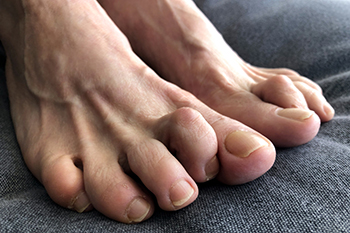
Hammertoe, a toe deformity resembling a hammer, can be a source of discomfort and mobility issues. While non-surgical treatments are often the first line of defense, surgical options become necessary when the condition is unresponsive to conservative measures, or if it reaches an advanced stage. The hallmark symptom of hammertoe is the upward bend in the middle toe joint, which, if left untreated, can lead to pain, blisters, calluses, or corns. When the discomfort becomes severe, surgical intervention may be recommended by your podiatrist. One common surgical approach is tendon lengthening, where the surgeon extends the tendon in the affected toe to enhance flexibility. This procedure aims to restore a more natural position to the toe and alleviate associated pain. Tendon transfer is another surgical option. In this procedure, part of a tendon from the bottom of the toe is moved to the top, enhancing flexibility and promoting a healthier range of motion in the toe. For cases where stability is compromised, joint fusion may be recommended. During this surgery, metal pins or screws are inserted into the toes, creating internal immobilization. Recovery periods may vary, and following postoperative instructions care is essential for the best results. To determine the most suitable surgical option based on the specifics of your hammertoe, it is suggested that you discuss the matter with a podiatrist.
Hammertoes can be a painful condition to live with. For more information, contact one of our podiatrists of Podiatry Care Specialists. Our doctors will answer any of your foot- and ankle-related questions.
Hammertoe
Hammertoe is a foot deformity that occurs due to an imbalance in the muscles, tendons, or ligaments that normally hold the toe straight. It can be caused by the type of shoes you wear, your foot structure, trauma, and certain disease processes.
Symptoms
- Painful and/or difficult toe movement
- Swelling
- Joint stiffness
- Calluses/Corns
- Physical deformity
Risk Factors
- Age – The risk of hammertoe increases with age
- Sex – Women are more likely to have hammertoe compared to men
- Toe Length – You are more likely to develop hammertoe if your second toe is longer than your big toe
- Certain Diseases – Arthritis and diabetes may make you more likely to develop hammertoe
Treatment
If you have hammertoe, you should change into a more comfortable shoe that provides enough room for your toes. Exercises such as picking up marbles may strengthen and stretch your toe muscles. Nevertheless, it is important to seek assistance from a podiatrist in order to determine the severity of your hammertoe and see which treatment option will work best for you.
If you have any questions, please feel free to contact our offices located in West Chester, and Broomall, PA . We offer the newest diagnostic and treatment technologies for all your foot care needs.
